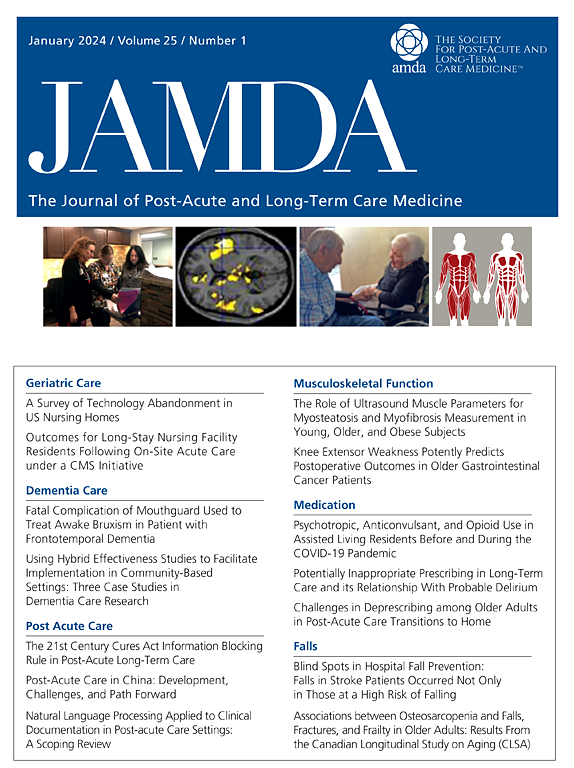Digital Technology Use in US Community-Dwelling Seniors With and Without Homebound Status
IF 4.2
2区 医学
Q2 GERIATRICS & GERONTOLOGY
Journal of the American Medical Directors Association
Pub Date : 2024-09-22
DOI:10.1016/j.jamda.2024.105284
引用次数: 0
Abstract
Objectives
To examine (1) the prevalence of digital technology use, including information and communication technology devices, everyday technology use, and digital health technology use among community-dwelling older adults with or without homebound status and (2) the associations of digital technology use with homebound status.
Design
Cross-sectional study.
Setting and Participants
We used the 2022 National Health and Aging Trends Study (NHATS) data that included 5510 community-dwelling older adults.
Methods
Digital technology use was assessed using self-reported outcomes of the technological environment component of the NHATS, including information and communication technology devices, everyday technology use, and digital health technology use. Homebound status was measured with 4 mobility-related questions regarding the frequency, independence, and difficulties of leaving home. Survey-weighted, binomial logistic regression was used to examine the associations of 17 technological-related outcomes and homebound status.
Results
Overall, the prevalence of homebound older adults was 5.2% (95% CI, 4.4%–6.1%), representing an estimated 2,516,403 people. The prevalence of digital technology use outcomes varied according to homebound status. The prevalence of any technology used in homebound, semi-homebound, and non-homebound populations was 88.5%, 93.3%, and 98.5%, respectively. Compared with non-homebound older adults, semi-homebound older adults had lower odds of emailing (OR, 0.71; 95% CI, 0.53–0.94), using the internet for any other reason (OR, 0.70; 95% CI, 0.49–0.99), visiting medical providers (OR, 0.68; 95% CI, 0.48–0.95), and handling insurance (OR, 0.75; 95% CI, 0.56–0.99); homebound older adults had lower odds of using a phone (OR, 0.41; 95% CI, 0.28–0.59), using any everyday technology (OR, 0.58; 95% CI, 0.38–0.89), visiting medical providers (OR, 0.52; 95% CI, 0.35–0.76), and handling insurance (OR, 0.57; 95% CI, 0.38–0.86).
Conclusions and Implications
Non-homebound older adults are more likely to use digital technology than those who are semi-homebound or homebound. Public health care providers should prioritize efforts to enhance digital inclusion to ensure that all older adults can benefit from the advantages of digital technology.
美国社区居家和非居家老年人的数字技术使用情况。
研究目的研究(1)有无居家状态的社区老年人使用数字技术的普遍程度,包括信息和通信技术设备、日常技术使用和数字健康技术使用;(2)数字技术使用与居家状态的关联:横断面研究:我们使用了 2022 年全国健康与老龄化趋势研究(NHATS)的数据,其中包括 5510 名居住在社区的老年人:方法:使用NHATS技术环境部分的自我报告结果来评估数字技术的使用情况,包括信息和通信技术设备、日常技术使用和数字健康技术使用情况。居家状态是通过 4 个与行动相关的问题来衡量的,这些问题涉及离家的频率、独立性和困难程度。采用调查加权二项逻辑回归法研究了 17 项技术相关结果与居家状态之间的关联:总体而言,居家老年人的比例为 5.2%(95% CI,4.4%-6.1%),估计有 2,516,403 人。数字技术使用率因居家状况而异。居家、半居家和非居家人群使用任何技术的比例分别为 88.5%、93.3% 和 98.5%。与不居家的老年人相比,半居家的老年人使用电子邮件(OR,0.71;95% CI,0.53-0.94)、因任何其他原因使用互联网(OR,0.70;95% CI,0.49-0.99)、访问医疗机构(OR,0.68;95% CI,0.48-0.95)和办理保险(OR,0.75;95% CI,0.56-0.99);居家老年人使用电话(OR,0.41;95% CI,0.28-0.59)、使用任何日常技术(OR,0.58;95% CI,0.38-0.89)、看望医疗提供者(OR,0.52;95% CI,0.35-0.76)和办理保险(OR,0.57;95% CI,0.38-0.86)的几率较低:与半居家或居家的老年人相比,不居家的老年人更有可能使用数字技术。公共医疗服务提供者应优先考虑加强数字包容性,以确保所有老年人都能从数字技术的优势中受益。
本文章由计算机程序翻译,如有差异,请以英文原文为准。
求助全文
约1分钟内获得全文
求助全文
来源期刊
CiteScore
11.10
自引率
6.60%
发文量
472
审稿时长
44 days
期刊介绍:
JAMDA, the official journal of AMDA - The Society for Post-Acute and Long-Term Care Medicine, is a leading peer-reviewed publication that offers practical information and research geared towards healthcare professionals in the post-acute and long-term care fields. It is also a valuable resource for policy-makers, organizational leaders, educators, and advocates.
The journal provides essential information for various healthcare professionals such as medical directors, attending physicians, nurses, consultant pharmacists, geriatric psychiatrists, nurse practitioners, physician assistants, physical and occupational therapists, social workers, and others involved in providing, overseeing, and promoting quality

 求助内容:
求助内容: 应助结果提醒方式:
应助结果提醒方式:


